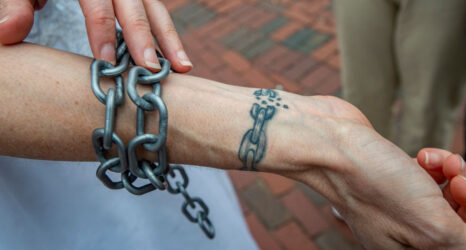Is a 13-year-old girl selling sex on the streets a criminal?

To pay tribute to five decades of reporting, rebelling and truth-telling, From the Vault includes some of our favorite feminist classics from the last 50 years of Ms. For more iconic, ground-breaking stories like this, order 50 YEARS OF Ms.: THE BEST OF THE PATHFINDING MAGAZINE THAT IGNITED A REVOLUTION (Alfred A. Knopf)—a stunning collection of the most audacious, norm-breaking coverage Ms. has published.
From The Vault: Jailing Girls for Men’s Crimes (Summer 2010)
B.W. was 13 years old when she offered to perform oral sex for $20 on an undercover officer in Texas. The officer arrested her and booked her as an adult. Despite evidence that B.W. had a history of sexual and physical abuse, was living with a 32-year-old “boyfriend” and under Texas law was considered incapable of consenting to sex because she was under 14, the county DA charged her with prostitution and obtained a conviction.
Is a 13-year-old girl selling sex on the streets a criminal? This question is now being asked around the nation, generating vigorous debate and concrete action.

In April, New York became the first state to enact a policy against prosecuting girls under age 18 for prostitution, with its groundbreaking Safe Harbor for Exploited Children Act. The act also provides support and services to sexually exploited youth under 16.
Similarly, Connecticut, Illinois and Washington recently passed laws that decriminalize prostituted children. The activists behind these laws all argue the same thing: Prostituted girls are victims of sex trafficking.
Katya from the Ukraine will be seen as a real victim, and provided with services and support, but Keisha from the Bronx will be seen as a willing participant,’someone who is out there because she likes it and who is criminalized and thrown in detention or jail.
Rachel Lloyd, Girls Educational and Mentoring Services (GEMS
At this point, “sex trafficking” tends to conjure images of girls in Southeast Asian brothels or women from former Soviet bloc states. Rarely do we think of U.S. girls as trafficked. Only this year, for the first time, did the U.S. State Department include this country in its annual Trafficking in Persons Report.
“As a nation, we’ve graded and rated other countries on how they address trafficking within their borders and yet have effectively ignored the sale of our own children within our own borders,” said Rachel Lloyd of the New York-based anti-trafficking organization Girls Educational and Mentoring Services (GEMS), in her testimony before Congress. “Katya from the Ukraine will be seen as a real victim, and provided with services and support, but Keisha from the Bronx will be seen as a willing participant, someone who is out there because she likes it and who is criminalized and thrown in detention or jail.”
The idea that the commercial sexual exploitation of girls is sex trafficking has, in fact, been established in U.S. federal law since the Trafficking Victims Protection Act went on the books in 2000, defining sex trafficking to include the commercial sexual exploitation of youth under 18, whether by consent or not.
At the federal level, this policy has been enforced: The FBI’s Innocence Lost National Initiative has removed more than a thousand children from prostitution and convicted more than 570 pimps since 2003.
However, the federal directive has been slow to take hold on the state and local levels: Police officers across the country still arrest sexually exploited girls and treat them as criminals. And studies show there are plenty of girls out there to arrest.
The National Center for Missing and Exploited Children estimates that 100,000 U.S. children each year are victims of commercial sexual exploitation within our borders. The Justice Department’s Child Exploitation and Obscenity Section estimates that nearly 300,000 U.S. youth are currently at risk of becoming victims of commercial sexual exploitation because they are runaways, throwaways, homeless or in other circumstances that make them particularly vulnerable to exploitation. In fact, according to 2009 figures from the Department of Justice, a third of sex-trafficking allegations in the United States involved minors, mostly girls. The median age of entry into prostitution in the United States is shockingly young: 12 to 14 years old for girls.
Despite these statistics, activists in this country have had to fight hard to get people to recognize and care about the situation. New York’s Safe Harbor Act is revolutionary in stating that sexually exploited girls under 18 are to be considered sex-trafficking victims, not criminals. Yet the state of Georgia recently rejected a similar safe-harbor law that would have exempted minor girls from prosecution for prostitution.
And who opposed it? The Georgia Christian Coalition, the Georgia Baptist Convention and other conservative organizations staged protests and letter-writing campaigns, claiming the law would legalize child prostitution. They argued that arresting girls was the best way to get them off the streets and out of the hands of pimps. Wrote Sue Ella Deadwyler, a conservative Christian activist, in her newsletter, Georgia Insight, “Some boys and girls know the law, defy the law and decide to choose prostitution as a way to make money.” So Georgia continues to criminalize prostituted girls even though, under Georgia’s statutory rape law, a girl under sixteen is not considered capable of consenting to sex.
The decision to prosecute these girls rather than provide a safe harbor only makes them more vulnerable and more numerous. A 2010 study shows that 500 girls aged seventeen and under are sold for sex each month in Georgia, with 7200 men paying for sex with adolescent females (whether they know their age or not). Meanwhile, as in Texas, the considerably older pimps and buyers almost always avoid arrest.
Nonetheless, activists in Atlanta are continuing their fight to change the situation. Arresting sexually exploited girls for prostitution is an egregious form of blaming the victim. Society’s treatment of these girls is rife with double standards: we care about abused girls abroad but not at home, we prosecute underage girls but not the adult men buying and pimping them, and we charge some young girls with prostitution while protecting others with statutory rape laws.
Lloyd attributes the lack of concern for the girls being prostituted to the fact that “the young people who are impacted by this in this country … are young people who live in poverty, they are young people who are in the child-welfare system or the juvenile justice system, and they are just not highly valued by society on many levels.” The buyers, however, are “regular men” from all parts of society: our legislatures, law enforcement, media, and the justice system, as well as teachers and clergy––”folks in power” who don’t want change.
Rather than blaming the victims, advocates around the country are calling on governments to stop arresting these girls and instead provide them with the social services they need, reserving criminal prosecution for the perpetrators the pimps and johns.
“In the last year or two,” says the attorney Karen Harpold of the Houston-based Children at Risk, “there has been so much more awareness about human trafficking and these problems. I think it’s changing, and I think there’s definitely that critical mass of people who are working on it to make real changes.”
“In 10 years,” adds Rachel Lloyd of GEMS, “we will look back and consider it ludicrous that we ever prosecuted children for prostitution.”
Up next:
U.S. democracy is at a dangerous inflection point—from the demise of abortion rights, to a lack of pay equity and parental leave, to skyrocketing maternal mortality, and attacks on trans health. Left unchecked, these crises will lead to wider gaps in political participation and representation. For 50 years, Ms. has been forging feminist journalism—reporting, rebelling and truth-telling from the front-lines, championing the Equal Rights Amendment, and centering the stories of those most impacted. With all that’s at stake for equality, we are redoubling our commitment for the next 50 years. In turn, we need your help, Support Ms. today with a donation—any amount that is meaningful to you. For as little as $5 each month, you’ll receive the print magazine along with our e-newsletters, action alerts, and invitations to Ms. Studios events and podcasts. We are grateful for your loyalty and ferocity.





